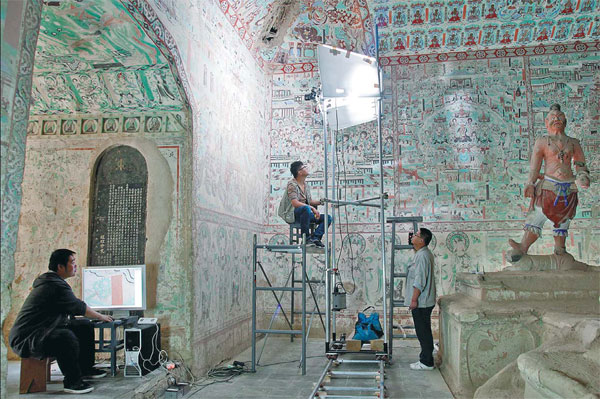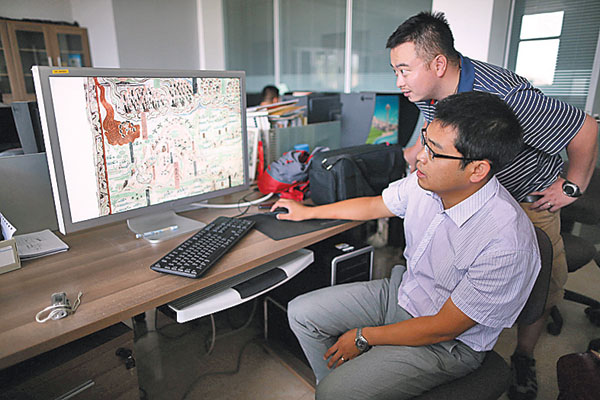 |
|
A photography team captures images of ancient murals in a cave of Dunhuang Mogao Grottoes, in Gansu province. Provided to China Daily
|
 |
|
Workers from Dunhuang Academy's digital center examine murals on computer. Chen Xi / For China Daily
|
Ancient murals in Dunhuang Mogao Grottoes are in danger of disintegrating. Preservationists are desperately trying to digitize the important relics before they are gone forever. Liu Wei reports.
'The murals are aging, like me," says Fan Jinshi, 75, president of Dunhuang Academy.
For 50 years Fan has been conserving and studying the murals and other splendid relics in Mogao Grottoes, one of the greatest cultural wonders of the world.
The paintings on the surfaces of caves dug into mountains in Dunhuang, a small town in Northwest China's Gansu province, are extremely fragile heritage.
The caves were built between the 4th and 14th centuries, through more than 10 successive Chinese dynasties. One generation of painters after another filled them with murals illustrating Buddhism and daily life.
These precious artworks, however, are now at risk from arid weather, natural deterioration and the impact of tourism.
Among the 735 caves in Dunhuang, 492 contain murals and colored statues. Sadly, half of the murals are at risk of being lost.
Fan and her colleagues believe the future preservation of the murals lies in digitization.
"The foremost purpose of digitization is to build a digital archive," says Sun Zhijun, deputy director of Dunhuang Academy's Digital Center. "So people can still appreciate the murals' beauty and study their value hundreds of years later."
The ambitious project started in 1999, when the Andrew W. Mellon Foundation funded a joint project between Dunhuang Academy and Northwestern University of the United States. Archivists digitized 22 caves in five years, using rails like train tracks to stabilize cameras moving over the uneven cave surfaces - hardware the American experts brought from Hollywood to capture the murals.
At first the team used traditional cameras, sent the film to the US and scanned the photos into a computer. Digital cameras were adopted in 2000, but the photos' resolution could only reach 75 DPI (dots per inch, or per 2.54 cm, a measure of printing resolution).
Thanks to the continuous upgrading of digital cameras, now the photos are of 300 DPI, good enough for archiving and printing.
We recommend:
Gansu's great Silk Road secrets
Terraces on top of the world
Ruins of Suoyang City to be evaluated for World Heritage list
